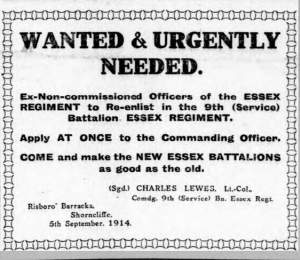9th Essex - Timeline from formation to operational in France 1914-1915
The battalion was based at Risborough Barracks, Shorncliffe.
Numbers grew fast from an initial 100 men to over 2,000 by early September.

Men were recruited to the Essex Barracks at Warley and then sent to Shorncliffe in batches.
The main recruiting areas for the 9th Essex were from rural Essex although some did come from East Ham, Ilford and Romford.
Felsted school provided five of the Officers.
The Essex Newsman reported the training and some illustrious members of the battalion.
Sir John Harrington served as British Minister to Emperor Menelik 2nd in Abyssinia and recently contested election to Parliament.
Corporal Collingwood-Denny was the Great Great Grandson of Lord Collingwood of Trafalgar fame, Corporal Beresford comes from a well known Irish family and Private J St. Vincent Jervis Hunter was a direct descendant of Viscount St Vincent who was an English maritime hero.
At this early stage of the war volunteers tended to join in small family or friend groups. The 9th Essex kept these existing groups together as far as possible to promote a quick bonding.
Recruiting was so effective that many of the men were transferred to for the 10th Essex.
In November 1917 Lieutenant Graham Dixon of the 9th Essex contacted the Essex Chronicle with an appeal that the public donate woolen garments, belts, shirts and socks to the battalion as they did not have sufficient for the coming winter.
In December 1917 Mrs Lewes, the CO's wife appealed for khaki text-align: -webkit-left; mittens or money to be donated so that every man could be given a pair as a Christmas present.
The newspaper then recorded that the South Weald Parish Needlework Party sent 1023 belts, 82 shirts and 102 pairs of socks to the 9th Essex.
During training Sir John Harrington left to command a new battalion and Captain Rome was posted to a battalion serving on the front line in France where sadly he was killed not long after his arrival.
Major Copeman then assumed the role as second in command.
Captain J Barrett Lennard assumed the role of A Company Commander
Captain C R Yates assumed the role of D Company Command.
Captain C B Joyner was badly injured during the training and was kept from active service due to the severity of injury.
One of the first fatalities occurred on 19 January 1915 when Private A J Wakefield was taken ill but died from Pneumonia in hospital the same evening.
In March 1915 the battalion was transferred to Blenheim Barracks at Aldershot and in May 1915 were transferred to France for active service.


